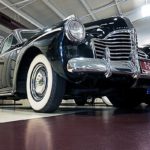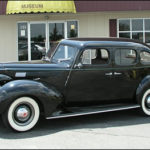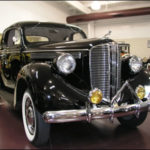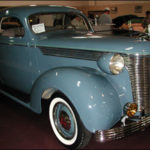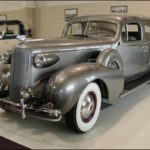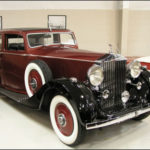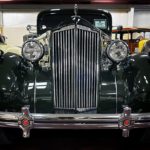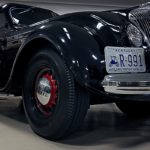Author Archives for adamgillrie
Carefully driven and maintained by its original owner, L. L. Kraft, this Buick is close to original, with just minor restoration where needed. It is a smooth driving car, and everything works. The odometer shows only 51,990 miles.1941 was the automobile industry's last full year of production before the united states entered world war II. And it was one of Buick's most successful years with the company producing 377,428 cars. Click Here for Audio Story
This custom-bodied Rolls Royce with its sculptured lines is an exceptional example of the classic presence and grace that have always been the hallmark of Rolls Royce Motor cars.
The elegant interior demonstrates extraordinary craftsmanship with its fine veneers, hand-finished furnishings and upholstery made from only the finest hides.
In December 1904, Henry Royce and the Hon. Charles S. Rolls signed a historic agreement founding the Rolls Royce Motor Company. It's goal: To set new standards of precision engineering and coachwork elegance. The expression, "Quality Remains Long After the Price is Forgotten" was first used by Rolls Royce.
Until this particular Rolls Royce was acquired by Swope's Cars of Yesteryear, it had remained with descendants of the family that originally purchased it.
Click Here for Audio Story
Model 1600 six-cylinder sedan with radio and heater. Engine: L-Head straight 6, 245 cubic inches. Synchromesh 3-speed transmission. Wheelbase was increased from 115 inches to 122 inches on the Packard Six for 1938.
During the depression of the 1930’s, it was the “Junior Packards” that saved the company. The famous Packard 120 Series was introduced in 1935, which enabled Packard to enter the mid-price field. Then, as a model in the “Junior” Series, a powerful six was added in 1937, bringing the price down still further to under $1,000. In 1938, the six-cylinder engine was increased to 245 cubic inches and 100 horsepower, with greater low speed torque. The car you see here is surprisingly nimble and responsive on the road.
Retaining the classic Packard look, the Junior Packards were popular cars. There was a lot of prestige that went along with owning a Packard; and in those days, the kind of car you drove, pretty much established you on the social ladder. If you drove a Packard, people did not have to ask or wonder how you were doing…they just knew!
Series D-8 Six Cylinder Engine.
217.8 Cubic Inch. L-Head.
Four Wheel Hydraulic Brakes.
3 speed Synchromesh Transmission.
An attractive, stylish car in 1938, this little beauty still gets approving glances as it glides quietly and smoothly along.
Almost seventy years old, this car has been pampered. Restoration was body off frame. Engine completely rebuilt. There is no evidence of any rust or collision damage. The low mileage showing on the odometer is believed to be correct. See this and many other magnificent machines of the past at Swope's Cars of Yesteryear Museum in Elizabethtown, Kentucky.
Swope Auto Center has sold and serviced Dodge products in Elizabethtown, Kentucky since 1952.
In 1928, Walter P. Chrysler was riding high. After only four short years of manufacturing, the Chrysler Corporation had risen to third place in the American motor industry. Acquiring the Maxwell plant in 1924, the first Chrysler cars came off the line late that year. Featuring four wheel hydraulic brakes, steel body construction, and a powerful six cylinder engine, Chrysler cars caught on quickly. 1928 was a significant year for the company. First, the Chrysler Corporation acquired the Dodge Brothers Motor Company, along with its 3,000 franchised Dodge dealers. Then came the brand new Plymouth to compete head to head with Ford and Chevrolet in the low price field. And finally DeSoto, was the first DeSoto models introduced to the public in 1929.
For over thirty years, DeSoto was a proud entry in the marketplace, finally fading from the scene in 1961. It was a good car, but it experienced difficulty finding its proper niche in the marketplace. Its problem: under the skin it was really a Chrysler, with little or no significant difference from the Chrysler Corporation’s popular flagship car. Therefore, DeSoto became something of a stepchild to Chrysler, much as LaSalle had became to Cadillac. DeSoto prospects oftentimes cho [...]
The Original cost of this magnificent luxury Cadillac was $3,535...expensive at the time. You could have purchased six Chevrolets for that kind of money. Approximately 80 Formal Town Sedans were produced, and this is one of two known to still exist.
This car, serial #4130367, was shipped from the factory on March 15, 1937, and was sold originally by Greenlease Letterman Cadillac of Tulsa, Oklahoma. Since being restored, it has won national first place awards from the Antique Auto Club of America, Classic Car Club of America, and The Concours D'Elegance.
Click Here for Audio Story
1936 Rolls Royce Phantom III Saloon Carriage With Window Division Coach Work By H.J. Mulliner of London, England
This custom-bodied Rolls Royce with its sculptured lines is an exceptional example of the classic presence and grace that have always been the hallmark of Rolls Royce Motor Cars. The elegant interior demonstrates extraordinary craftsmanship with its fine veneers, hand-finished furnishings and upholstery made from only the finest hides. In December 1904, Henry Royce and the Hon. Charles S. Rolls signed a historic agreement founding the Rolls Royce Motor Car Company. Its goal: To set new standards of precision engineering and coach work elegance. The expression "Quality remains long after the price is forgotten" was first used by Rolls Royce. This Rolls Royce was discovered "Barn Fresh" in Louisville, Kentucky in 2003. The refinishing and detailing was done by Swope Auto Center Technicians. Click Here for Audio StoryThe model is so named because the car's wheelbase is 120 inches - the B shows that 1936 was the second year for the 120 series Packard. Engine: 282 cubic inch straight eight. Its 120 horsepower could push this car close to 100 mph.
There were 3,976 Packard 120B Touring Coups (Style 994) built in 1936. This is one of five known to still exist. The 120 series Packards were smaller than the big "senior" Packards, but still every inch a Packard. Although not considered a "Classic," the Packard 120 with its sculptured body and authentic Packard hood and grille was one of the most beautiful cars of its day. By competing price wise with Buick, Chrysler and other mid range cars, the 120's saved the day for Packard during the great depression of the 1930's. They were great cars. It was during the 1930's, and conditions were tough. Only a few people could afford one of the big classic Packards. Packard Motor Company saw a need to compete with Buick, Chrysler, Hupmobile, Hudson, and others in the mid-price range...hence, the 120 series. Although not truly a "classic," the Packard 120 with its sculptured body and authentic Packard hood grille was one of the most beautiful cars of its day. It quickly c [...]
Considered the most influential car of the 1930’s, the Chrysler Airflow was the brainchild of engineer, Carl Breer, who put into it the most modern concepts of automotive and aviation design. Airflow bodies were constructed around a cage-like steel girder network, to which the body panels were welded. The body and chassis were one integral unit, making the Airflow the forerunner of today’s unit body construction.
The unit body was so strong, that in a widely reported publicity stunt, an Airflow was driven off a 100 foot cliff, bounced down the cliff face, landed on all four wheels, then promptly driven off under its own power.
The Custom Imperial was powered by Chrysler’s largest 323 cubic inch in-line eight, rated at 130 horsepower. Wheelbase was a huge 137 inches. Weight was approximately 2½ tons.
1936 price: $2,475. (A huge figure in that depression year)
Although years ahead of its time, its advanced, extreme styling, hurt sales of the Airflow. Only 38 of the model you see here were built, making this a very rare car, indeed.
Click Here for Audio Story
